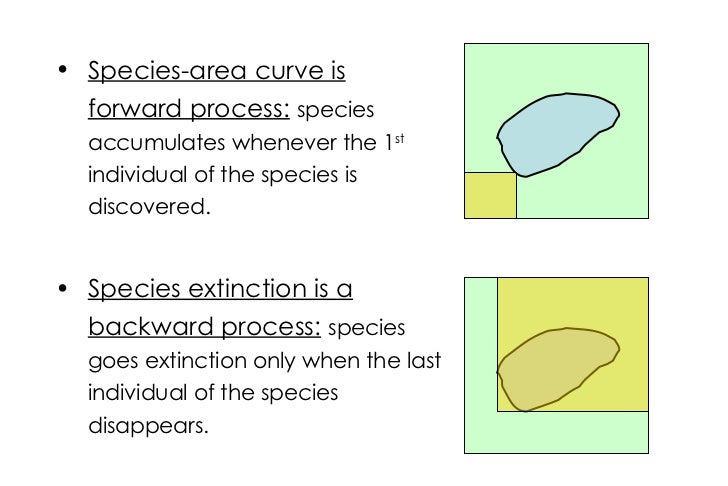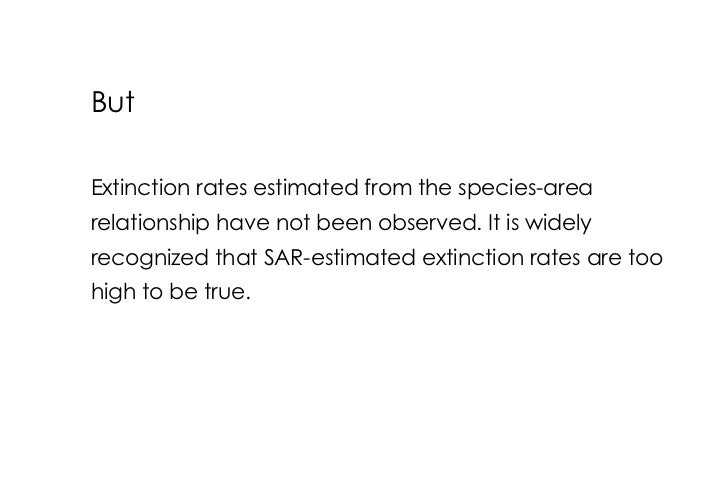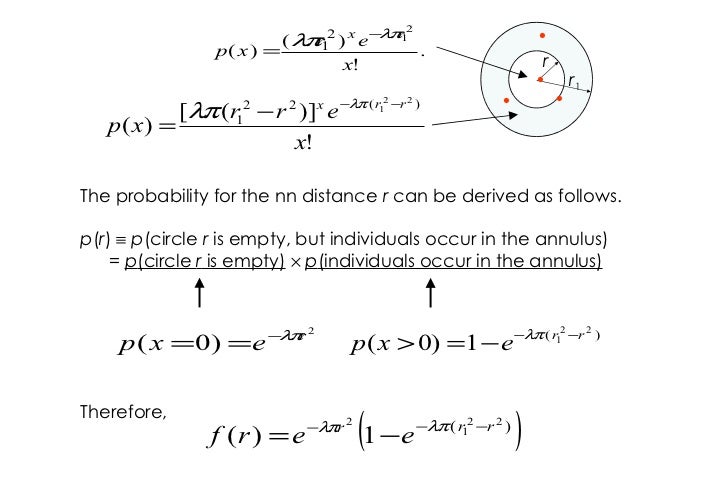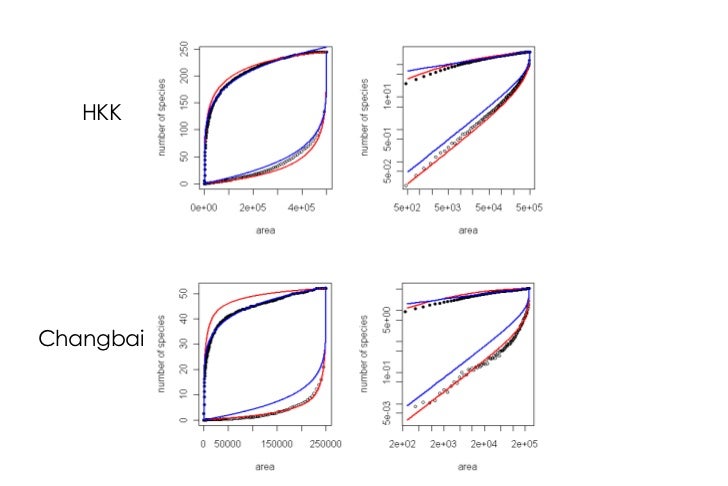Habitat destruction and the extinction debt pdf
Extinction debt or habitat change? – Ongoing losses of woodland birds in north-eastern New South Wales, Australia. – Ongoing losses of woodland birds in north-eastern New South Wales, Australia. Biological Conservation 142 , 3182–3190.
Extinction threshold is a term used in conservation biology to explain the point at which a species, population or metapopulation, experiences an abrupt change in density or number because of an important parameter, such as habitat loss.
A very important published analysis of the problem of habitat destruction (Tilman et al. 1994 [Nature 371:65‐66]) concluded that such destruction may lead to an extinction debt, which is the irreversible, preferential loss of competitive species following a prolonged transient or delay after the habitat destruction.
The Extinction – Download as Powerpoint Presentation (.ppt / .pptx), PDF File (.pdf), Text File (.txt) or view presentation slides online. The Extinction of all animals
Biodiversity dynamics under intransitive competition and habitat destruction Matthew J. Labrum Department of Mathematics, Washington State University, Pullman, USA Goal To investigate how biodiversity is affected by intransitive competition and habitat destruction in …
At first, extinction rates are high, and then decelerate until the point at which half of the extinction debt is paid off. After that point, species loss continues but at a slower rate until a new
arrangement and rate of habitat destruction, and the size of habitat (Tilman et al. 1994, 1997b). The magnitude of the extinc- The magnitude of the extinc- tion debt, however, varies considerably, depending on the abundance of the best competitors (Tilman et al. 1997b).
initial, temporary, and final habitat destruction values. Conditions that hinder detection of an extinction debt also provide Conditions that hinder detection of an extinction debt also provide forgiving restoration timeframes.
Destruction and fragmentation of natural and semi-natural habitats are considered as major threats for plant species richness. However, the response of plant species richness to habitat alteration is sometimes delayed. This delay induces an extinction debt in plant communities that are thus prone to
habitat destruction is the leading cause of extinction; hence, a focusing of efforts on under- standing this phenomenon may provide great rewards for guiding conservation efforts that limit the magnitude of biodiversity loss and mitigate the associated negative consequences on
Extinction debt occurs because of time delays between impacts on a species, such as destruction of habitat, and the species’ ultimate disappearance. For instance, long-lived trees may survive for many years even after reproduction of new trees has become impossible, and thus they may be committed to extinction.
examine the species extinction debt incurred as habitat that the better competitors are poor colonizers while destruction increases and attempt to predict the characteris- …
Abstract HABITAT destruction is the major cause of species extinctions 1-3. Dominant species often are considered to be free of this threat because they are abundant in the undisturbed fragments that remain after destruction.
THe STaTe Of auSTRalia’S BiRDS 2009 Supplement to Wingspan, vol. 20, no. 1, March 2010. 2 The STaTe of auSTralia’S BirdS 2009 The STaTe of auSTralia’S BirdS 2009 T he State of Australia’s Birds reports are overviews of the status of Australia’s birds, the threats they face and the conservation actions taken. This seventh annual report focuses on revegetation for woodland birds
HABITAT destruction is the major cause of species extinctions1 3. Dominant species often are considered to be free of this threat because they are abundant in …
Extinction debt is the expected future losses of species in response to present habitat loss, yet it is a phenomenon that can easily go unnoticed (Kuussaari et al., 2009).
The new extinction projections come from applying a well-known ecological pattern, the species–area relationship (SAR), to data on the current distributions and climatic requirements of 1103 species.
In addition, the trend of threatened species moving into categories closer to risk of extinction has slowed, with 51% of all currently listed threatened species categorised as endangered or critically endangered, the same proportion as in SoE 2012.
Review Climate change species–area curves and the

(PDF) Habitat Destruction and the Extinction Debt
What is Habitat Destruction? A habitat is the natural place where plants, animals, or other organisms live; it is where they call home. This is the living area necessary for an ecosystem to remain
extinction debt inverse to low area loss old habitat patches, little depending on the area loss threshold (60%, 70%, 80% or 90%) considered for the distinction between the high and low area loss patches.
Reference : Plant species extinction debt in a biodiversity hotspot: community and species approaches
文章 . Loehle C, Li BL (1996) Habitat destruction and the extinction debt revisited. Ecological Applications 6: 784–789. 被如下文章引用:
Two extinction orders emerged under habitat destruction: either the best competitor becomes extinct first or the best colonizer first. The extinction debt and order, as well as the time lag between habitat destruction and species extinction, were found to be determined by species abundance and the intensity of the Allee effect.
A very important published analysis of the problem of habitat destruction (Tilman et al. 1994 [Nature 371:65-66]) concluded that such destruction may lead to an extinction debt, which is the irreversible, preferential loss of competitive species following a prolonged transient or delay after the
Keywords: Conservation, extinction cascades, extinction debt, grassland communities, habitat loss, habitat management, landscape change, relaxation time, species longevity Introduction Loss of biodiversity is a worldwide concern.
Causes of Natural Habitat Loss and Destruction Knowing that the death of wildlife and negative environmental impact are the results of habitat loss, it’s reasonable to question why we continue to carry on habits that destroy biodiversity .
Habitat destruction, often caused by anthropogenic disturbance, can lead to the extinction of species at an unprecedented rate. It is important, therefore, to consider habitat destruction when assessing population viability.
For habitat destruction on regional scales (reduction in ecosystem area without disturbance in remnant areas), one must, in contrast, apply species-area relations based on the distribution of different habitat types (e.g., elevational and rainfall gradients, physiographic and edaphic variability).

The current amphibian extinction rate may range from 25,039 to 45,474 times the background extinction rate. Frogs, toads, and salamanders are disappearing because of habitat loss, water and air pollution, climate change, ultraviolet light exposure, introduced exotic species, and disease.
In a related paper, Tilman used this model to demonstrate the phenomenon of “extinction debt,” which refers to the time delay between habitat destruction and the extinction of …
Title: Untitled-36 Created Date: 6/7/2002 4:15:10 AM

extinction debt. This refers to the extinction of species or populations long after habitat alteration. extinction vortex. As populations decline, an insidious mutual reinforcement occurs among biotic and abiotic processes driving population size downward to extinction. extirpation. This refers to extinction of a population rather than of an entire species. invasive species. These are
Extinction-debt theory holds that following habitat destruction, some extant species in remnants of habitat are doomed to eventual extinction. The extinction debt will affect the interpretation of ongoing impacts and extinctions, because little is understood about the changes in species abundance
This time-lag represents an ‘‘extinction debt’’ (Tilman et al. 1994) a future ecological cost of habitat destruction that may not be initially apparent in studies made shortly after
Growing Extinction Debt. Predicting, and potentially preventing, extinction is a central goal of conservation biology. Wearn et al. (p. 228; see the Perspective by Rangel) describe a mathematical approach for predicting the time lags in extinction following habitat loss.
One of the proposed outcomes of such habitat destruction is an extinction debt (Tilman et al. 1994), which suggests that asynchronous population dynamics in sources and sinks will cause a reduction in diversity some time after habitat destruction takes place. Other outcomes could include the modification of the abiotic habitat or the loss of habitat heterogeneity, both of which could have
Habitat F ragmen tation and Bio div ersit y Collapse under Recruitmen t Limitation Ricard V. Sol e 1; 2 and Da vid Alonso 3 1 Complex Systems R ese ar ch Gr oup, FEN
A very important published analysis of the problem of habitat destruction (Tilman et al. 1994 [Nature 371:65-66]) concluded that such destruction may lead to an extinction debt, which is the
Habitat destruction is the process by which natural habitat is damaged or destroyed to such an extent that it no longer is capable of supporting the species and ecological communities that naturally occur there. It often results in the extinction of species and, as a result, the loss of biodiversity
Habitat destruction threatens the viability of many populations, but its full consequences can take considerable time to unfold. Much of the discourse surrounding extinction debts—the number of species that persist transiently following habitat loss, despite being headed for extinction—frames
Read “Habitat destruction and the extinction debt, Biological Conservation” on DeepDyve, the largest online rental service for scholarly research with thousands of academic publications available at …
THe STaTe Of auSTRalia’S BiRDS 2009 BirdLife
destruction is restricted to a local and small area, its accumulation increases the risk of extinction. To study To study local destruction of habitat, we present …
The concept of the extinction debt has two components: a direct timelag between an environmental perturbation and the consequent extinction of a species and the idea that among species going extinct the strong competitors/weak colonizers go extinct first.
Habitat is a key element in defining or demonstrating biodiversity value in many financial standards, which often contain a specific definition of habitat. This definition is tailored to the standard and its application. For example, the
extinction debt of forest plants persists for more than a CENTURY FOLLOWING HABITAT FRAGMENTATION M ARK V ELLEND , 1,6 K RIS V ERHEYEN , 2 H ANS J ACQUEMYN , 3 A NNETTE K OLB , 4 H ANS V AN C ALSTER , 3
Extinction may also take place very long after the destruction of habitat, a phenomenon known as extinction debt. Habitat destruction can also decrease the range of certain organism populations. This can result in the reduction of genetic diversity and perhaps the production of
RELATIVE EFFECTS OF HABITAT LOSS AND FRAGMENTATION ON POPULATION EXTINCTION LENORE FAHRIG, Ottawa-Carleton Institute of Biology, Carleton University, ON K1S 5B6, Canada
Extinction debt is the future extinction of species in an area due to past events and occurs because of delays between impacts on a species, such as habitat destruction and fragmentation. Extinction debt is most likely found in long-lived species, such as trees and woody shrubs, – list of festivals celebrated in india pdf title = “Habitat destruction and the extinction debt”, abstract = “Habitat destruction is the major cause of species extinctions 1-3. Dominant species often are considered to be free of this threat because they are abundant in the undisturbed fragments that remain after destruction.
Habitat destruction and the extinction debt revisited: The Allee effect It is important, therefore, to consider habitat destruction when assessing population viability. Another factor often ignored in population viability analysis, is the Allee effect that adds to the risk of populations already on the verge of extinction.
Extinction debt’s wiki: In ecology, extinction debt is the future extinction of species due to events in the past. Extinction debt occurs because of time delays between impacts on a species, like destruction of habitat, and the species’ ultimate disappearance.
The three main types of habitat loss are habitat destruction, habitat degradation and habitat fragmentation. As the late Steve Irwin put it, “I believe our biggest issue is the same biggest issue that the whole world is facing, and that’s habitat destruction.” Habitat loss is a serious problem for
The model incorporates lags in extinction and immigration, which lead to extinction debt and immigration credit, respectively. Collectively, these concepts enable a balanced consideration of changes in biodiversity following climate change, habitat fragmentation and other forcing events. They also reveal transient phenomena, such as biodiversity surpluses and deficits, which have important
Local extinction of species can occur with a substantial delay following habitat loss or degradation. Accumulating evidence suggests that such extinction debts pose a significant but often unrecognized challenge for biodiversity conservation across a wide range of taxa and ecosystems.
decline, and extinction . There is also some research which indicates that habitat loss may There is also some research which indicates that habitat loss may cause the selective extinction of key species which are important for ecosystem function .
Untitled-36 [ped.fas.harvard.edu]
Synergies among extinction drivers under global change Barry W. Brook1, Navjot S. Sodhi2 and Corey J.A. Bradshaw1,3,4 1Research Institute for Climate Change and Sustainability, School of Earth and Environmental Sciences, University of Adelaide,
Save. In ecology, extinction debt is the future extinction of species due to events in the past. Extinction debt occurs because of time delays between impacts on a species, such as destruction of habitat, and the species’ ultimate disappearance.
Extinction may take place very long after the destruction of habitat, however, a phenomenon known as extinction debt. Habitat destruction can also decrease the range of certain organism populations. This can result in the reduction of genetic diversity and perhaps the production of
Global extinction results when habitat destruction reduces the proportion of suitable patches below a critical threshold. The PO model successfully recreates the extinction patterns found in other models. We translated the PO model into a stochastic cellular automaton. Fractal arrangements of suitable and unsuitable patches were used to simulate habitat fragmentation. We found that: (i) a
Habitat destruction and the extinction debt revisited: The Allee effect. Mathematical Biosciences 221: 26-32. Chiba S, Okochi I, Ohbayashi T, Miura D, Mori H, Kimura K, Wada S 2009.
Extinction debt repayment via timely habitat restoration

Species Extinction from Anthropogenic Disturbance Versus
The more fragmented a habitat already is, the greater is the number of extinctions caused by added destruction. Because such extinctions occur generations after fragmentation, they represent a debt – a future ecological cost of current habitat destruction.
TESTING COEXISTENCE OF EXTINCTION DEBT AND

Causes Effects and Solutions For Habitat Loss and
EXTINCTION DEBT OF FOREST PLANTS PERSISTS FOR MORE

Habitat Loss Fragmentation and Destruction ThoughtCo
Habitat Destruction and the Extinction Debt Revisited
– Extinction Debt and Windows of Conservation Opportunity in
Modelling coral reef biodiversity and habitat destruction


Habitat destruction and the extinction debt infona.pl
Loehle C Li BL (1996) Habitat destruction and the
Biodiversity dynamics under intransitive competition and
Extinction debt Wikipedia
Local extinction of species can occur with a substantial delay following habitat loss or degradation. Accumulating evidence suggests that such extinction debts pose a significant but often unrecognized challenge for biodiversity conservation across a wide range of taxa and ecosystems.
Extinction debt or habitat change? – Ongoing losses of woodland birds in north-eastern New South Wales, Australia. – Ongoing losses of woodland birds in north-eastern New South Wales, Australia. Biological Conservation 142 , 3182–3190.
arrangement and rate of habitat destruction, and the size of habitat (Tilman et al. 1994, 1997b). The magnitude of the extinc- The magnitude of the extinc- tion debt, however, varies considerably, depending on the abundance of the best competitors (Tilman et al. 1997b).
Habitat destruction is the process by which natural habitat is damaged or destroyed to such an extent that it no longer is capable of supporting the species and ecological communities that naturally occur there. It often results in the extinction of species and, as a result, the loss of biodiversity
This time-lag represents an ‘‘extinction debt’’ (Tilman et al. 1994) a future ecological cost of habitat destruction that may not be initially apparent in studies made shortly after
Keywords: Conservation, extinction cascades, extinction debt, grassland communities, habitat loss, habitat management, landscape change, relaxation time, species longevity Introduction Loss of biodiversity is a worldwide concern.
extinction debt. This refers to the extinction of species or populations long after habitat alteration. extinction vortex. As populations decline, an insidious mutual reinforcement occurs among biotic and abiotic processes driving population size downward to extinction. extirpation. This refers to extinction of a population rather than of an entire species. invasive species. These are
HABITAT destruction is the major cause of species extinctions1 3. Dominant species often are considered to be free of this threat because they are abundant in …
Loss of habitats and local species extinctions Study of
Habitat fragmentation and extinction thresholds on fractal
Destruction and fragmentation of natural and semi-natural habitats are considered as major threats for plant species richness. However, the response of plant species richness to habitat alteration is sometimes delayed. This delay induces an extinction debt in plant communities that are thus prone to
Global extinction results when habitat destruction reduces the proportion of suitable patches below a critical threshold. The PO model successfully recreates the extinction patterns found in other models. We translated the PO model into a stochastic cellular automaton. Fractal arrangements of suitable and unsuitable patches were used to simulate habitat fragmentation. We found that: (i) a
RELATIVE EFFECTS OF HABITAT LOSS AND FRAGMENTATION ON POPULATION EXTINCTION LENORE FAHRIG, Ottawa-Carleton Institute of Biology, Carleton University, ON K1S 5B6, Canada
This time-lag represents an ‘‘extinction debt’’ (Tilman et al. 1994) a future ecological cost of habitat destruction that may not be initially apparent in studies made shortly after
The new extinction projections come from applying a well-known ecological pattern, the species–area relationship (SAR), to data on the current distributions and climatic requirements of 1103 species.
extinction debt inverse to low area loss old habitat patches, little depending on the area loss threshold (60%, 70%, 80% or 90%) considered for the distinction between the high and low area loss patches.
initial, temporary, and final habitat destruction values. Conditions that hinder detection of an extinction debt also provide Conditions that hinder detection of an extinction debt also provide forgiving restoration timeframes.
habitat destruction is the leading cause of extinction; hence, a focusing of efforts on under- standing this phenomenon may provide great rewards for guiding conservation efforts that limit the magnitude of biodiversity loss and mitigate the associated negative consequences on
In addition, the trend of threatened species moving into categories closer to risk of extinction has slowed, with 51% of all currently listed threatened species categorised as endangered or critically endangered, the same proportion as in SoE 2012.
Extinction debt’s wiki: In ecology, extinction debt is the future extinction of species due to events in the past. Extinction debt occurs because of time delays between impacts on a species, like destruction of habitat, and the species’ ultimate disappearance.
Habitat destruction and the extinction debt revisited: The Allee effect It is important, therefore, to consider habitat destruction when assessing population viability. Another factor often ignored in population viability analysis, is the Allee effect that adds to the risk of populations already on the verge of extinction.
Habitat is a key element in defining or demonstrating biodiversity value in many financial standards, which often contain a specific definition of habitat. This definition is tailored to the standard and its application. For example, the
arrangement and rate of habitat destruction, and the size of habitat (Tilman et al. 1994, 1997b). The magnitude of the extinc- The magnitude of the extinc- tion debt, however, varies considerably, depending on the abundance of the best competitors (Tilman et al. 1997b).
Biodiversity dynamics under intransitive competition and habitat destruction Matthew J. Labrum Department of Mathematics, Washington State University, Pullman, USA Goal To investigate how biodiversity is affected by intransitive competition and habitat destruction in …
Habitat destruction and the extinction debt infona.pl
Habitat destruction and the extinction debt revisited
Extinction debt is the expected future losses of species in response to present habitat loss, yet it is a phenomenon that can easily go unnoticed (Kuussaari et al., 2009).
Habitat destruction is the process by which natural habitat is damaged or destroyed to such an extent that it no longer is capable of supporting the species and ecological communities that naturally occur there. It often results in the extinction of species and, as a result, the loss of biodiversity
arrangement and rate of habitat destruction, and the size of habitat (Tilman et al. 1994, 1997b). The magnitude of the extinc- The magnitude of the extinc- tion debt, however, varies considerably, depending on the abundance of the best competitors (Tilman et al. 1997b).
Extinction may also take place very long after the destruction of habitat, a phenomenon known as extinction debt. Habitat destruction can also decrease the range of certain organism populations. This can result in the reduction of genetic diversity and perhaps the production of
Balancing biodiversity in a changing environment
Habitat destruction and the extinction debt
Causes of Natural Habitat Loss and Destruction Knowing that the death of wildlife and negative environmental impact are the results of habitat loss, it’s reasonable to question why we continue to carry on habits that destroy biodiversity .
decline, and extinction . There is also some research which indicates that habitat loss may There is also some research which indicates that habitat loss may cause the selective extinction of key species which are important for ecosystem function .
文章 . Loehle C, Li BL (1996) Habitat destruction and the extinction debt revisited. Ecological Applications 6: 784–789. 被如下文章引用:
extinction debt. This refers to the extinction of species or populations long after habitat alteration. extinction vortex. As populations decline, an insidious mutual reinforcement occurs among biotic and abiotic processes driving population size downward to extinction. extirpation. This refers to extinction of a population rather than of an entire species. invasive species. These are
Abstract HABITAT destruction is the major cause of species extinctions 1-3. Dominant species often are considered to be free of this threat because they are abundant in the undisturbed fragments that remain after destruction.
Extinction threshold is a term used in conservation biology to explain the point at which a species, population or metapopulation, experiences an abrupt change in density or number because of an important parameter, such as habitat loss.
Growing Extinction Debt. Predicting, and potentially preventing, extinction is a central goal of conservation biology. Wearn et al. (p. 228; see the Perspective by Rangel) describe a mathematical approach for predicting the time lags in extinction following habitat loss.
Extinction-debt theory holds that following habitat destruction, some extant species in remnants of habitat are doomed to eventual extinction. The extinction debt will affect the interpretation of ongoing impacts and extinctions, because little is understood about the changes in species abundance
The current amphibian extinction rate may range from 25,039 to 45,474 times the background extinction rate. Frogs, toads, and salamanders are disappearing because of habitat loss, water and air pollution, climate change, ultraviolet light exposure, introduced exotic species, and disease.

THe STaTe Of auSTRalia’S BiRDS 2009 Supplement to Wingspan, vol. 20, no. 1, March 2010. 2 The STaTe of auSTralia’S BirdS 2009 The STaTe of auSTralia’S BirdS 2009 T he State of Australia’s Birds reports are overviews of the status of Australia’s birds, the threats they face and the conservation actions taken. This seventh annual report focuses on revegetation for woodland birds
Relative Effects of Habitat Loss and Fragmentation on
Extinction threshold Wikipedia